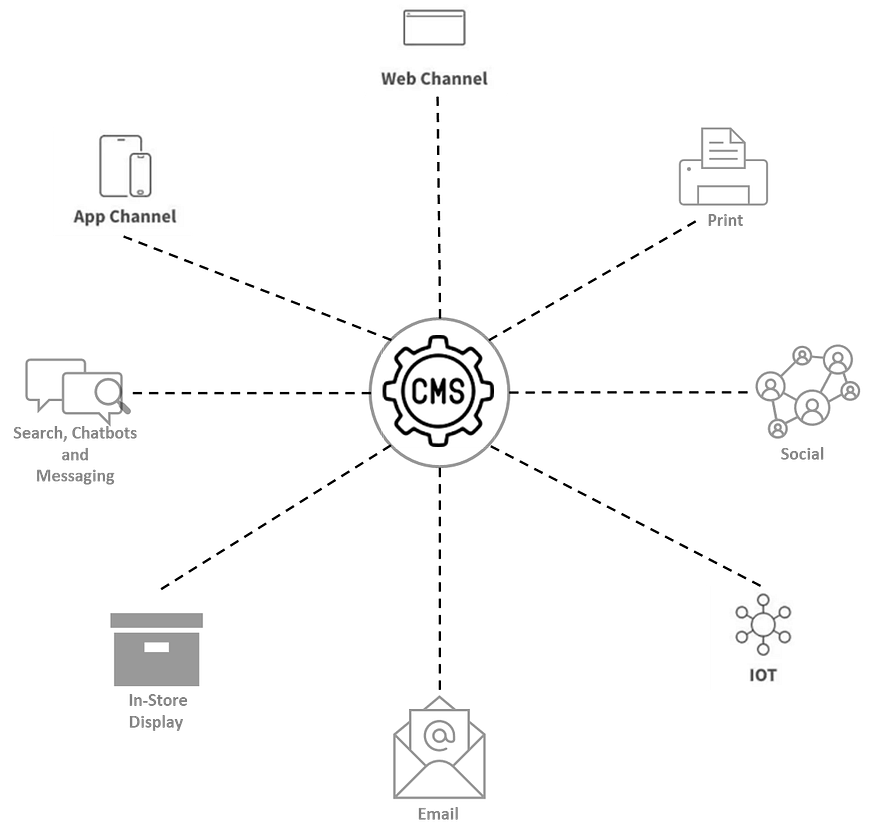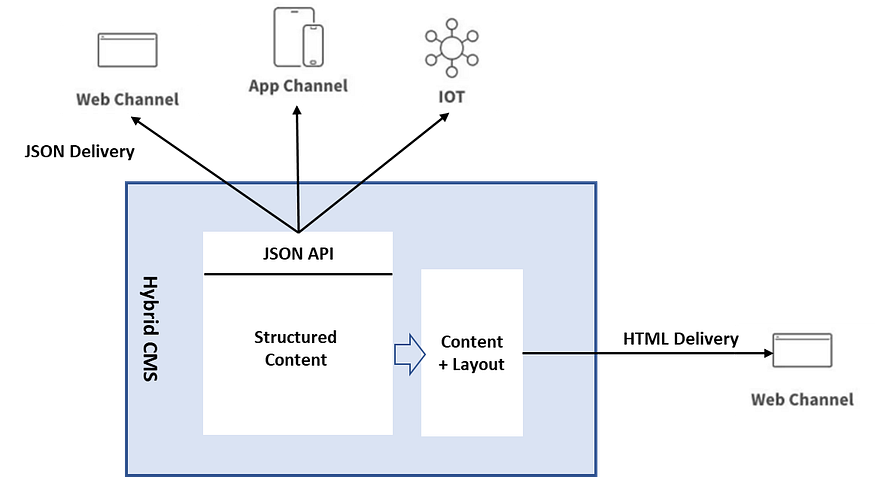The world of content management has evolved dramatically, and in today’s digital landscape, mastering the art of omni-channel content management is paramount. In my previous post, Exploring Atomic, Modular, and Headless Content Paradigms | by Albin Issac | Tech Learnings | Oct 2023 | Medium, we were exploring more on Atomic, Modular, and Headless content paradigms; in this post, we’ll explore the intricacies of omnichannel content strategy, examining how businesses can seamlessly integrate and deliver consistent messaging across diverse communication channels.
What is Omni-channel Content?
Omni-channel refers to a seamless and consistent experience across multiple channels, ensuring that users can switch between different devices or platforms and have a unified and continuous user experience. When we talk about omnichannel content, we refer to content designed and structured to be delivered across multiple platforms and devices without losing its context or relevance.
This might include:
- Websites
- Mobile apps
- Social media platforms
- Physical stores (via digital signage or kiosks)
- Call centers
- And more

Challenges of Omni-channel Management:
In omnichannel content management, several challenges await those striving to perfect their strategy. These hurdles include:
- Content Consistency: Upholding a harmonious brand message and content identity across many platforms presents a formidable challenge. Ensuring that a promotional offer featured on a website aligns seamlessly with what’s being advertised on the brand’s social media channels is crucial.
- Adaptability: Versatility is the name of the game in omnichannel content management. Content must be capable of adapting to the unique specifications of each device or platform while preserving its essence. For instance, a product description might need to be presented differently on a mobile app than a digital kiosk, but the fundamental message should remain consistent.
- Real-time Updates: In today’s fast-paced digital landscape, the demand for keeping content up to date across all channels in real-time can pose logistical challenges. Timely and synchronized updates are paramount to providing users with accurate and relevant information.
- Personalization: With abundant user data available, the modern audience expects content tailored to their individual preferences and behaviors. Achieving this level of personalization at scale necessitates implementing advanced tools and strategies.
The fundamental principle underpinning omnichannel content management is that content should exhibit adaptability, consistency, and personalization, regardless of how or where customers engage.
Benefits of Omni-channel Content Management:
- Uniformity Across Platforms: Omni-channel content management ensures that regardless of where your audience interacts with your brand, they are met with consistent content and messaging. This fosters trust and familiarity among your customers.
- Operational Efficiency: Gone are the days of independently juggling content on multiple platforms. With omni-channel management, content deployment becomes seamless, freeing up resources and reducing overheads.
- Precision in Delivery: Leveraging a singular content source drastically reduces the chances of discrepancies or errors. This guarantees that your audience always receives accurate and dependable information.
- Content Personalization: With a centralized data repository, designing content that resonates more closely with individual user preferences becomes feasible. This not only boosts engagement but also deepens customer relationships.
- Adaptability in a Dynamic Market: The digital market is in perpetual flux. Omni-channel content management enables brands to promptly modify content based on emerging trends or fresh data insights.
Effective Omni-channel Content Strategies:
Efficiently managing omnichannel content hinges on the utilization of a robust Content Management System (CMS) that provides:
- Centralized Content Repository: Establishing a singular source of truth for all content ensures that updates and alterations propagate seamlessly across all channels.
- Personalization: The capacity to tailor content based on user behavior, preferences, or demographic data boosts engagement and imparts a personalized touch to each customer’s experience.
- Content Adaptation: Ensuring content displays optimally and attractively across many devices and platforms guarantees a unified and captivating user experience, regardless of the chosen channel.
- Integration Capabilities: Seamless connectivity with other systems, encompassing social media platforms, campaign management systems, and more, facilitates the efficient sharing and distribution of content. This integration enables a cohesive approach to content management, guaranteeing content reaches the right audience through the most pertinent channels.
Modern Content Management Systems (CMSs) have evolved to streamline the process of disseminating content across diverse digital formats and channels. Gone are the days of crafting content separately for each platform. Today, organizations can originate content from a central location and effortlessly deploy it wherever needed. Two primary types of CMSs, known as headless and hybrid, excel in enabling omnichannel content delivery. They operate with an API-first approach, separating content from its display, thus empowering users to publish content to any device or channel whenever required.
Key Considerations for Omni-channel Content:
- Adaptive Responsive Design: The variety of devices and screen dimensions available today necessitates that your content remains fluid. It should automatically adjust to provide optimal viewing and interaction experience, whether on a smartphone, tablet, desktop, or any other device.
- Robust Content Governance: Beyond just creation, the content lifecycle requires rigorous oversight. Establish clear approval processes to maintain content’s quality and relevance. Version control becomes indispensable in this context, ensuring every channel synchronizes with your content’s latest, most accurate version.
- Leveraging Data for Strategic Decisions: Understanding content performance is paramount in today’s data-driven world. Brands can garner insights into what resonates with their audience by continually monitoring content across channels. Harnessing these analytics informs current content strategies and anticipates future trends and preferences.
- Personalization Capabilities: With the convergence of multiple channels, offering content that feels tailor-made for the user is essential. This demands a system that can capture, analyze, and act upon user behaviors and preferences to deliver relevant and engaging content.
- Integration with Other Systems: To truly achieve an omni-channel experience, your content management system must seamlessly integrate with other enterprise systems, be it CRM, e-commerce platforms, or marketing automation tools. This ensures data consistency and a unified brand experience across all touchpoints.
- Security and Compliance: As you distribute content across multiple channels, ensuring your content’s and user data’s security becomes crucial. Implement robust security protocols to prevent unauthorized access, breaches, and data leaks.
- Scalability and Flexibility: Brands’ content needs will also expand as they grow and evolve. Opting for a system that scales with your growth ensures that you won’t face roadblocks in the future. Furthermore, flexibility in adapting to new technologies, channels, or market demands is essential for longevity in a rapidly changing digital landscape.
- User Training and Support: Adopting an omnichannel approach might involve introducing new tools or platforms to your teams. Providing adequate training ensures that they can utilize these tools effectively. Moreover, ensuring ongoing support helps troubleshoot and stay updated with the latest features and best practices.
Integration with Various Channels:
Integrating diverse channels with a Content Management System (CMS) is vital. This allows the CMS to manage content centrally, making it readily available to various systems and channels as needed. Modern Hybrid and Headless CMSs utilize APIs to disseminate content across distinct systems and channels. These systems can then access the CMS’s APIs to retrieve the latest relevant version of content, ensuring a cohesive experience across various customer touchpoints.
The headless CMS systems independently manage the content and share it through API.

The hybrid CMS system operates differently; the shared content can be managed as structured content and shared through API to different channels, and the same shared structured content can be used within the CMS system to enable websites through in-context editing.

Many CMS platforms also support or provide connectors to facilitate integration, enabling effortless content sharing. The choice between using an API or a connector often hinges on specific needs and availability. While connectors offer smooth integration, they may demand more maintenance over time. Conversely, while the API-centric method requires an initial investment in effort, its long-term maintenance is generally less intensive.

Tools and Platforms:
Leverage a Content Management System (CMS) like Adobe Experience Manager (AEM), Sitecore, or Contentful/Content Stack, etc., which supports omnichannel content management, offering capabilities like centralized content repositories, APIs, or connectors for content delivery to various channels and features for personalization and automation.
Implementation Blueprint:
- Comprehensive Review: Conduct an exhaustive analysis of current systems, integrations, and data pathways to ascertain existing capacities and limitations.
- Strategic Formulation: Establish well-defined objectives that resonate with your organization’s broader ambitions. Craft a strategy that seamlessly dovetails with these goals.
- System Setup: Deploy and tailor platforms in a manner that is congruent with the devised strategy, ensuring they serve the intended purpose efficiently.
- Integration and Quality Assurance: Prioritize the smooth integration of platforms. Undertake meticulous testing regimes to guarantee data precision and uniformity across systems.
- Deployment and Continuous Refinement: Roll out the formulated strategy, keep an attentive eye on its real-world performance, and perpetually fine-tune it based on tangible insights and performance indicators.
Conclusion:
Omni-channel content management is more than just sharing content on different platforms. At its core, it emphasizes delivering a unified, tailored, and consistent content experience, no matter the platform. By combining content management methods, brands can better connect with their audience everywhere and improve efficiency while maintaining high-quality and consistent content.
No comments:
Post a Comment